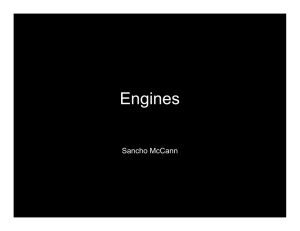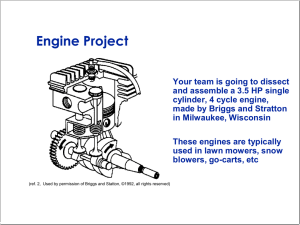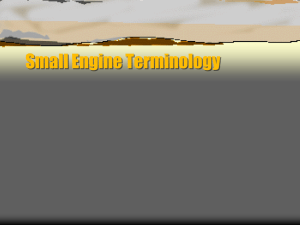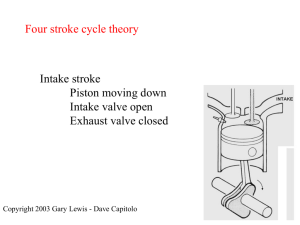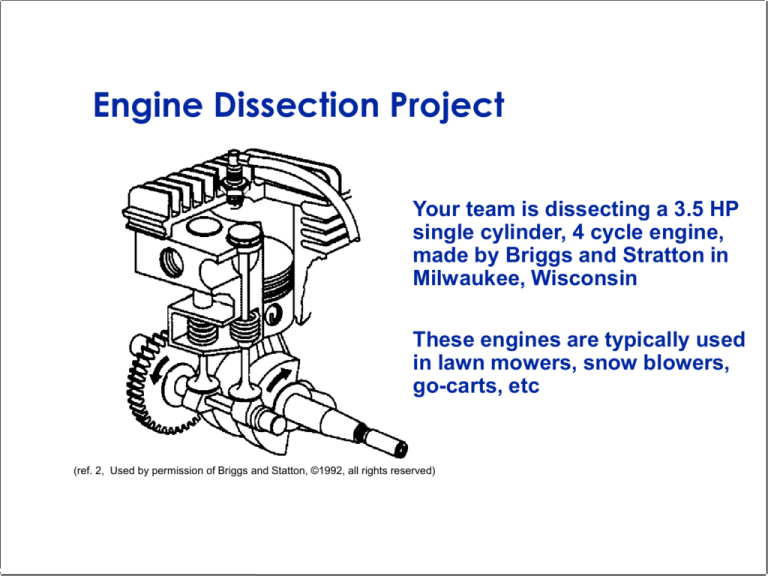
Engine Dissection Project
Your team is dissecting a 3.5 HP
single cylinder, 4 cycle engine,
made by Briggs and Stratton in
Milwaukee, Wisconsin
These engines are typically used
in lawn mowers, snow blowers,
go-carts, etc
(ref. 2, Used by permission of Briggs and Statton, ©1992, all rights reserved)
Engine Dissection Project
Start engine.
Disassemble engine.
Review parts and functions – Ask questions!
Reassemble engine.
Re-start engine.
Write individual report on how engine works.
4 Cycle Process
1
Intake Valve
Intake
Manifold
Cylinder
2
Exhaust Valve
Exhaust
Manifold
3
4
Spark
Plug
Piston
Connecting
Rod
Intake Stroke
Intake valve opens,
admitting fuel and air.
Exhaust valve closed
for most of stroke
Crank
Crankcase
Compression Stroke
Both valves closed,
Fuel/air mixture is
compressed by rising
piston. Spark ignites
mixture near end of
stroke.
Power Stroke
Fuel-air mixture burns,
increasing temperature
and pressure, expansion
of combustion gases
drives piston down. Both
valves closed - exhaust
valve opens near end
of stroke
Exhaust Stroke
Exhaust valve open,
exhaust products are
displaced from cylinder.
Intake valve opens
near end of stroke.
1. Intake
2. Compression
3. Power
4. Exhaust
Reciprocating to rotary motion
The pistons & crankshaft
Image from:
http://www.eng.iastate.edu/explorer/topics/car/engine.htm
Piston, crankshaft,
& fly wheel
Image from:
www.web-masters.com/ gms/crank_p.html
Piston
Image from:
www.rbracing-rsr.com/ 113orca.htm
darryl.hudson.home.mindspring.com/
ww.eng.iastate.edu/explorer/topics/car/engine.htm
Crankshaft
Image from :
toyotaperformance.com/crankshaft_kits.htm
Several common types of car engine arrangement
Image from :
Automotive mechanics, 8th ed. By William H. Crouse
4 cylinder in-line
6 cylinder in-line
V-6
V-8
Flat-4 engine
Flat-6 engine
Power strokes in 2 crankshaft rotations
Why you need flywheel
Image from :
Automotive mechanics, 8th ed. By William H. Crouse
4 cylinder
6 cylinder
Output
torque
8 cylinder
Output
torque
time
Output
torque
time
time
rocker
Valve Mechanisms:
How you get the
valve
right timing
push rod
Image from :
Automotive mechanics, 8th ed. By William H. Crouse
piston
valve lifter
camshaft
cam
crankshaft
Timing marks
Lubrication
Image from :
Automotive mechanics, 8th ed. By William H. Crouse
Venturi-type Carburetor
The carburetor of our engine
Choke
Throttle
Venturi
Higher Pressure
Outside Engine
Fuel
How do engines work?
How does the engine complete these Primary Functions?
Hint
Get started?
Suck in fuel?
Suck in air?
Mix air and fuel?
Compress the mixture?
Ignite the mixture (at the right time)?
Make the combusting gases do work?
Make the work available to somebody?
Exhaust the gases?
Shut off?
Think about the parts and processes involved for each.
How do engines work?
How does the engine complete these Secondary Functions?
Hint
Stay lubricated?
Operate the valves at the right time?
Smooth out the power pulses?
Store the fuel?
Keep cool?
Make it easy to start?
Think about the parts and processes involved for each.
Some variations:
Fuel Injection
(electronic, multi-port)
Monitored Engine
Operating Conditions:
Manifold Pressure
Engine Speed
Air Temperature
Coolant Temperature
Acceleration
COMPUTER
TRIGGER
INJECTOR DRIVE UNIT
Pressure Regulator
Fuel
Filter
50 psi typical
Injectors
FUEL TANK
Fuel
Pump
More variations:
OHC( overhead camshaft):
DOHC, SOHC……
Rocker
Valve spring
Valve
Valve lifter
Camshaft
Piston
Image from :
Automotive mechanics, 8th ed. By William H. Crouse
Connecting
rod
Crankshaft
More variations:
VTEC( Variable valve timing and lift electronic control)
2 Stroke Process (for comparison)
Compression
(ports closed)
Air Taken Into
Crankcase
Combustion
(ports closed)
Exhaust
(intake port closed)
Air compressed in crankcase
Scavenging
and Intake
(ports open)
Wankel Rotary Engine
•Smoother
•Engine is continuously moving in one direction
rather than changing direction like in piston
engines.
•Slower
•Main moving parts move slower which increase
the reliability of the engine.
•Fewer Moving Parts
•The rotary engine consists of three main moving
parts while a piston engine contains at least 40
moving parts.
•Challenges
•Passing the US Emissions tests.
•Manufacturing costs are higher.
•Consumes more fuel.
This presentation created by former ENGR 100 students Sam Henry, Thomas Munsey, Grayson Deitering, Daniel Munro




